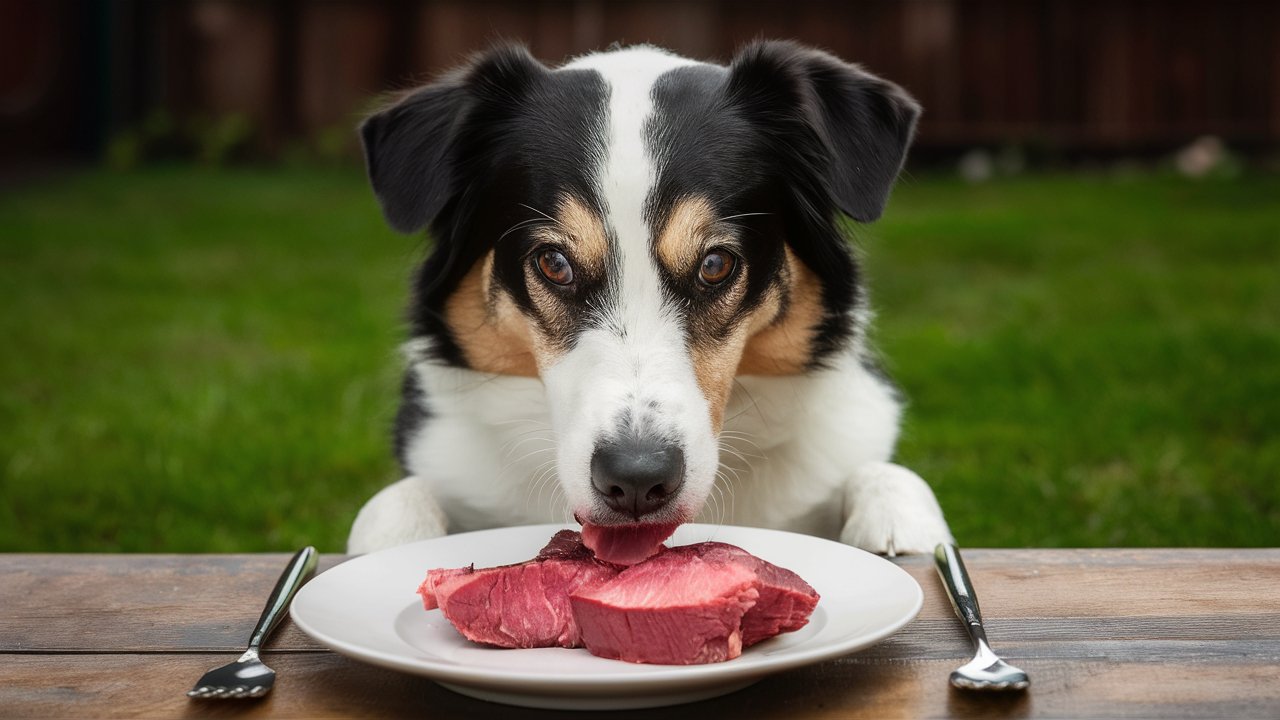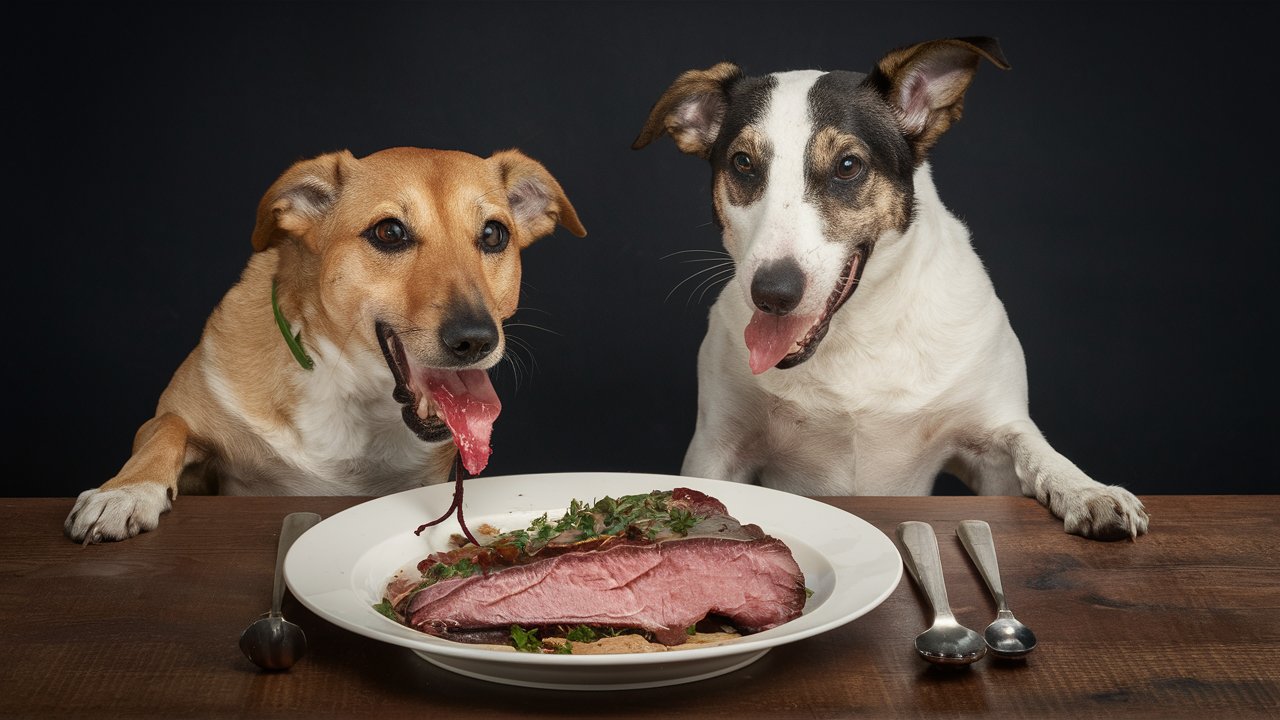Dogs are more than just pets; they’re family members who deserve the best care, including a nutritious diet. Can Dogs Eat Steak If you’re a steak lover, you’ve probably wondered if it’s safe to share this delicious treat with your furry friend. After all, steak is rich in protein and other nutrients that seem like they’d be beneficial for dogs. But is it really safe for them to eat steak? Let’s dive into the details and find out.

Table of Contents
ToggleUnderstanding a Dog’s Nutritional Needs
Dogs require a diet that is rich in protein, fats, vitamins, and minerals. Protein is particularly important as it supports muscle development, immune function, and overall health. While commercial dog foods are formulated to meet these needs, many owners like to supplement their dog’s diet with fresh meats, including steak.
Protein Requirements for Dogs: Dogs need a substantial amount of protein in their diet, typically around 18-25% of their daily intake, depending on their age, size, and activity level. Steak, being a rich source of high-quality protein, can certainly contribute to this requirement.
Essential Nutrients in a Dog’s Diet: In addition to protein, dogs need fats, carbohydrates, vitamins, and minerals. Steak provides not just protein, but also important nutrients like iron, zinc, and B vitamins, which are vital for energy production and maintaining a healthy coat and skin.
Types of Steak: Which Are Safe for Dogs?
When it comes to feeding steak to your dog, not all types are created equal.
Cooked vs. Raw Steak: Cooked steak is generally safer than raw, as cooking kills harmful bacteria like Salmonella and E. coli. However, raw feeding advocates argue that raw steak can be part of a dog’s natural diet. The key is ensuring that the meat is fresh and handled properly.
Different Cuts of Steak: Some cuts of steak are leaner, while others are higher in fat. For example, ribeye and T-bone steaks are more marbled with fat, which can be too rich for some dogs. On the other hand, sirloin is a leaner option that may be better suited for canine consumption.
Grass-Fed vs. Grain-Fed Beef: Grass-fed beef is often touted as healthier because it’s leaner and contains more omega-3 fatty acids. While this might be a better option for health-conscious dog owners, both grass-fed and grain-fed beef can be safe for dogs as long as they are prepared correctly.
The Benefits of Feeding Steak to Dogs
Steak can offer several health benefits when included in a dog’s diet in moderation.
High-Quality Protein Source: Steak is an excellent source of complete protein, providing all the essential amino acids that dogs need to thrive. This can be particularly beneficial for active dogs who need extra protein to maintain muscle mass.
Rich in Vitamins and Minerals: Steak is packed with nutrients like B vitamins, which support energy metabolism, and minerals like iron and zinc, which are crucial for maintaining a healthy immune system and promoting wound healing.
Contribution to Muscle Health and Energy: The protein and fat content in steak can help support muscle repair and provide a concentrated source of energy, making it a good occasional treat for dogs with high energy levels.
Potential Risks of Feeding Steak to Dogs
While steak has its benefits, there are also risks associated with feeding it to your dog.
High Fat Content and Pancreatitis Risk: Some cuts of steak are high in fat, which can lead to obesity and pancreatitis, a serious and painful condition where the pancreas becomes inflamed. Dogs prone to pancreatitis should avoid fatty cuts of steak.
Seasonings and Additives to Avoid: Many seasonings that humans enjoy on steak, such as garlic, onions, and certain spices, are toxic to dogs. It’s essential to feed your dog plain, unseasoned steak to avoid any harmful side effects.
Bones: Why They’re Dangerous: While it might seem natural to give your dog a bone from a steak, cooked bones are brittle and can splinter, causing choking or severe internal injuries. It’s best to avoid giving your dog any type of cooked bone.
Risk of Foodborne Illness from Raw Steak: Raw steak can harbor harmful bacteria like Salmonella and E. coli, which can cause severe gastrointestinal issues in dogs. If you choose to feed your dog raw steak, make sure it’s fresh and handle it with care.
Cooked Steak: Safe Preparation for Dogs
If you decide to cook steak for your dog, here’s how to do it safely.
Best Cooking Methods for Dog-Friendly Steak: Grill, bake, or boil the steak without any added oils or seasonings. The goal is to cook the steak thoroughly while keeping it plain.
Avoiding Seasonings and Sauces: Never add salt, pepper, garlic, onions, or any other seasoning to your dog’s steak. These ingredients can be toxic or at the very least, unhealthy for your dog.
Proper Portion Sizes: Dogs don’t need large amounts of steak. A small portion, appropriate to your dog’s size, is sufficient. For example, a small dog might only need a few bites, while a large dog could handle a few ounces.
Raw Steak: Can Dogs Eat Steak?
Raw feeding has become more popular, but it’s not without controversy.
Pros and Cons of Raw Feeding: Advocates of raw feeding claim it’s more natural and beneficial for dogs, supporting better digestion and shinier coats. However, the risks include exposure to bacteria and parasites, which can be dangerous.
Safety Measures for Feeding Raw Steak: If you opt for raw steak, make sure it’s from a reliable source and as fresh as possible. Practice good hygiene by washing your hands and any surfaces that come into contact with the raw meat.
Balancing a Raw Diet: Raw steak should be part of a balanced diet that includes a variety of meats, organs, and bones. Consult with a vet or a canine nutritionist to ensure your dog’s raw diet is complete.

Signs of Steak-Related Health Issues in Dogs
Watch for signs that your dog might be having trouble with steak.
Symptoms of Fat Overload and Pancreatitis: If your dog consumes too much fat, they may experience vomiting, diarrhea, and abdominal pain. In severe cases, pancreatitis can develop, requiring immediate veterinary care.
Recognizing Allergic Reactions: Some dogs might be allergic to beef. Symptoms of an allergy include itching, swelling, hives, and gastrointestinal distress. If you suspect an allergy, stop feeding steak and consult your vet.
Digestive Issues: What to Watch For: Steak, especially if it’s rich or fatty, can cause digestive upset in dogs, leading to diarrhea or constipation. If your dog seems to have trouble after eating steak, it might not be the best treat for them.
What to Do if Your Dog Eats Too Much Steak
Sometimes, dogs get into food they shouldn’t. Here’s what to do if your dog eats too much steak.
Immediate Steps to Take: Monitor your dog for any signs of distress, such as vomiting, diarrhea, or lethargy. Ensure they have plenty of water and avoid feeding them anything else for a few hours to let their stomach settle.
When to Consult a Veterinarian: If your dog shows signs of serious illness, such as repeated vomiting, severe diarrhea, or pain, contact your vet immediately. Pancreatitis and other conditions can be life-threatening if not treated promptly.
Long-Term Dietary Adjustments: If your dog has a sensitive stomach or is prone to weight gain, it might be best to limit or eliminate steak from their diet.
Alternative Protein Sources for Dogs
Steak isn’t the only option for giving your dog a protein boost.
Chicken, Turkey, and Fish: These are leaner protein sources that are easier on a dog’s digestive system and lower in fat, making them safer options for regular feeding.
Lamb and Pork: These meats can also be fed to dogs, but like steak, they should be given in moderation due to their higher fat content.
Plant-Based Proteins: Are They Sufficient? While dogs are omnivores, they thrive best on animal-based proteins. However, some dogs do well on diets that include plant-based Cilantro like lentils and chickpeas, particularly if they have meat allergies.
How Often Should You Feed Steak to Your Dog?
Even if your dog loves steak, moderation is key.
Determining the Right Frequency: Steak should be an occasional treat rather than a regular part of your dog’s diet. Once or twice a month is usually sufficient for most dogs.
Balancing Steak with Other Foods: Make sure that your dog’s overall diet is balanced. Steak can be included as part of a diet that also features other meats, vegetables, and high-quality kibble or wet food.
Special Considerations for Puppies and Senior Dogs: Puppies and older dogs have different nutritional needs. Puppies require more protein for growth, while senior dogs might need lower-fat diets. Adjust the frequency and portion size of steak accordingly.
Veterinary Opinions on Feeding Steak to Dogs
What do the experts say about dogs eating steak?
What Experts Say About Steak in a Dog’s Diet: Many vets agree that while steak can be a good source of protein, it should be given sparingly. They emphasize the importance of a balanced diet that meets all of a dog’s nutritional needs.
Research on Red Meat and Dog Health: Some studies suggest that excessive consumption of red meat could be linked to health issues in dogs, such as heart disease or cancer.
Recommendations for Dog Owners: Vets generally recommend that if you do feed steak, it should be lean, unseasoned, and given in small amounts as part of a balanced diet.

Homemade Dog Meals Featuring Steak
If you’re keen on including steak in your dog’s diet, here are some ideas.
Simple Recipes for Dog-Friendly Steak Dishes: Consider mixing small pieces of cooked steak with brown rice and steamed vegetables for a balanced homemade meal. You can also combine steak with sweet potatoes for added nutrients.
Balancing Steak with Other Nutrients: Always ensure that your homemade meals include a variety of food groups. Adding some cooked vegetables and grains can help round out the meal.
Storage and Serving Tips: Store cooked steak in the fridge for up to three days, and make sure it’s fully reheated before serving to avoid foodborne illness.
Conclusion
Steak can be a tasty and nutritious treat for dogs when prepared and served properly. However, it should be given in moderation and as part of a balanced diet. By understanding the risks and benefits, you can make an informed decision about whether to include steak in your dog’s meals. Always consult with your veterinarian to ensure that any new food you introduce is safe and appropriate for your dog’s specific needs.
FAQs
- Can Dogs Eat Steak Bones?
- No, cooked steak bones are dangerous as they can splinter and cause choking or internal injuries.
- How Much Steak Is Too Much for a Dog?
- A few ounces of plain, lean steak once or twice a month is usually enough.
- Can Steak Cause Allergies in Dogs?
- Yes, some dogs may be allergic to beef. Watch for signs like itching, swelling, or gastrointestinal distress.
- Is Grass-Fed Beef Better for Dogs?
- Grass-fed beef is leaner and contains more omega-3 fatty acids, which might be healthier for your dog, but both grass-fed and grain-fed beef can be safe.
- What Are Some Safe Seasonings for Dogs?
- It’s best to avoid seasoning steak for dogs. Plain, unseasoned steak is the safest option to prevent any adverse reactions.

I’m Haseem Ali, a passionate writer focused on dog diet, health, training, lifestyle, and care. I’m dedicated to sharing expert advice and practical tips to help fellow dog owners provide the best for their furry friends. When I’m not writing, I enjoy spending time with my own dogs and exploring new pet-friendly activities.
